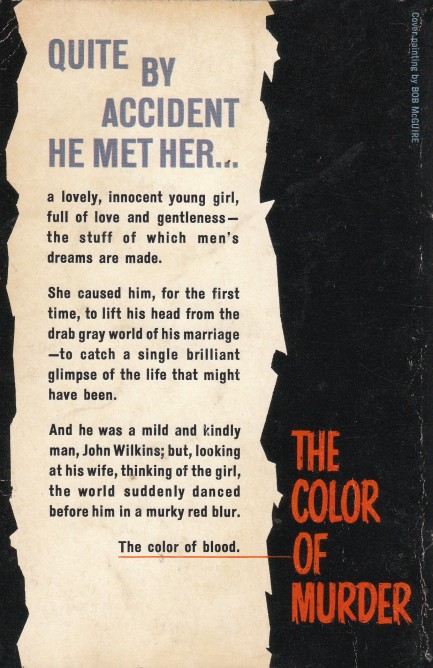 Gonna wait till the midnight hour, when there's no one else around. 
 Above you see a cover effort by Gerald Gregg for Helen McCloy's 1945 mystery The Man in the Moonlight. This is from Dell Publications, and you probably recognized it right away as a mapback edition. You see that here too, with its fictive university campus. Above you see a cover effort by Gerald Gregg for Helen McCloy's 1945 mystery The Man in the Moonlight. This is from Dell Publications, and you probably recognized it right away as a mapback edition. You see that here too, with its fictive university campus.
The story is a variation of a locked room mystery, however it requires more than the usual helping of suspension of disbelief from readers. Basically, a university psychologist stages an experiment that's, more than anything, a form of live action role playing in which a colleague is to attempt to achieve the circumstances needed to commit a murder. But the psychologist is really testing more than his willing maze rat suspects, which is why in the midst of the experiment the parameters suddenly change in a way designed to induce panic. We won't get into the ethics of that.
It's during this emotional experiment that the murder occurs, and it just happens that police detective Patrick Foyle is on campus when it happens. He's on the case in seconds, but much of the investigation (and narrative) falls to a psychiatrist named Basil Willing. Between cop and headshrinker the culprit will out, as they always do. We didn't really buy any of it, but we did like the fact that the story was set in 1940 and brought in the specter of Nazi involvement. Here's a fun line: Even in the infinitely remote world of the molecule [no-spoiler] ran afoul of Nazi policy. It's always been true—fascists get their noses deep into everything.
 Colonials in South Africa experience a different type of rhythm and blues. 
South Pacific. South America. South of France. We don't care—we love books sets in exotic places wherever they might be. Tell It on the Drums takes readers to South Africa as five men attempt to escape with $250,000 in diamonds from a dusty mining town called Kimberley and reach Pretoria. The story is basically a western escape tale, set in the late 1800s, when places like the Orange Free State and Cape Colony still existed, and the law was something that could be outdistanced on the back of a good horse. Pursuit is inevitable, but paranoia too. And as you'd expect, the real problem is not the law but the fractious partnership between the quintet of fugitives, which includes fearsome U.S. Civil War rebel Adam, craven Boer mercenary Coenraad, and compulsive French thief Dénis.
The 24/7 throbbing of drums is intelligible to tribespeople, and relays news in rhythm about the robbery. The five fugitives are soon known throughout the land, as are their movements and deeds. They have an inkling reports of their heist have travelled by air, but still think they're escaping secretly. It's an illusion. Too bad none of them understand the drums, because they begin urging that the quintet be herded north for some mysterious purpose. Surprisingly, Krepps splits the group up at that point in the story. Coenraad and Dénis trek upcountry to trick tribesmen out of their riches. Adam and one other continue fleeing to Pretoria. The inside man-turned-unwilling accomplice bolts into the veldt but is taken on by a veteran hunter. All the while the drums say: north, send them north, and it's clear that a reckoning looms.
We'll stop there, but we want to note a great set piece—to steal a cinematic term—involving a mass charge by twenty enraged baboons. It's a centerpiece sequence, all teeth, fangs, gunsmoke, and blood, and it's well written. Krepps is a solid writer on all fronts. Tell It on the Drums moves quickly and there are no moments where the narrative falters or feels forced. All the usual warnings about mid-century literature set in Africa apply, but in this case Krepps gives South African tribespeople agency via his device of coded drum talk. Drums speak in most novels of this type, but this time they're in all places at all times, surrounding the white men, and seem to be the entity in control. It adds a nice layer of dread. Overall, an excellent book, with nice cover art by Robert Stanley.
 Symons reflects on exactly how bad a man's life can be. 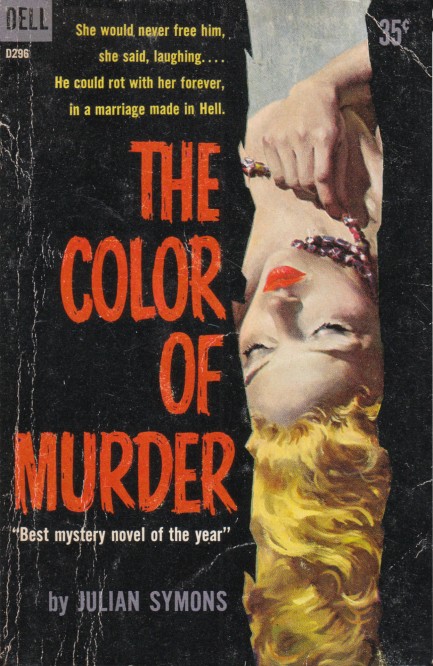
Looking for a bit more depth in your murder mysteries? 1957's The Color of Murder by British author Julian Symons takes a literary approach to the genre, examining the torturous existence of sad sack office drone John Wilkins, who hates his wife, covets the neighborhood librarian, and suffers from blackouts at times of stress (uh oh). Symons divides the novel roughly in half. In the first, Wilkins explains in first person to a psychologist how he came to be mired in a terrible life and loveless marriage, his account stopping before the murder (which if he actually committed, he'd presumably have blacked out anyway). The second half follows in third person the course of Wilkins' trial, with assorted twists, and there's an epilogue providing final focus. Whether or not Wilkins is a killer, he's a pitiable human. If you think you have an unsatisfactory life, read The Color of Murder to learn how well-off you really are. The cover art on this Dell edition is by Robert Maguire.
 Some people never even make it to the first day of Christmas. 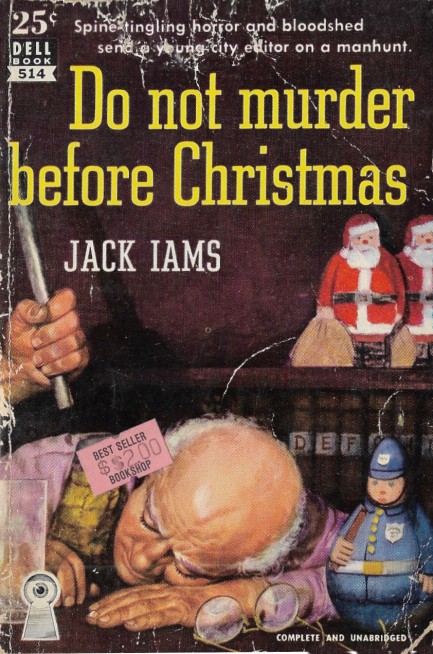
We thought about sharing this cover earlier, but decided to be literal with the title and reveal nothing until after Christmas. Do Not Murder Before Christmas was written by Jack Iams and published in 1949 in hardback by William Morrow & Co., then by Dell as a paperback a bit later the same year. It's a murder mystery in the Agatha Christie vein about an elderly smalltown toymaker whose secret knowledge of his community gets him killed when someone decides to suppress evidence of a crime.
While these sorts of whodunnits aren't hard-boiled or particularly action packed, they're often superior within the crime genre because of their humanized relationships and relatable women. This one is no exception, as a crucial aspect of the puzzle revolves around Jane Hewes, local beauty who's desired by both the scion of a wealthy family that has exploited the town for generations, and by the everyman newspaper editor who has spent years writing unflattering articles about that family. Their rivalry adds plenty to the story. They even have a fistfight.
This is the second Iams mystery we've read, along with Girl Meets Body, and it's clear that he can write as well as construct. The central plot contrivance—that every child who ever came to the toymaker's shop signed a visitor's book, and this somehow has the power to expose a killer—is something so leftfield we had to marvel. The tale's winning protagonist and involving love story make the final result a total winner. If you find an Iams novel anywhere, snag it.

 The cost is only everything she has. 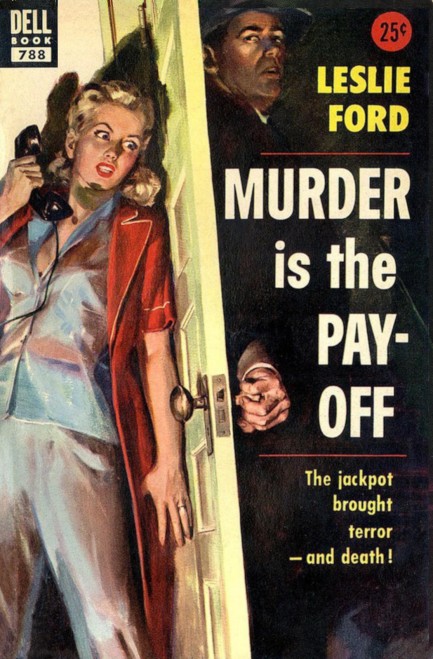
As you know, we're fascinated by pseudonyms. Murder Is the Pay-Off came from the typewriter of Leslie Ford, whose real name was Zenith Jones Brown. We can't imagine why she decided not to publish this under her own name. After reading it, we think the book must represent something close to the zenith of her authorial output. It's an interesting and well written mystery originally published in 1951, with this Dell edition coming in 1954 fronted by Carl Bobertz cover art. The novel is set in the fictional New York City satellite burg of Smithville, where the murder of a slot machine magnate turns the close knit community upside down. A lot happens in the book (in that upper crust, smalltown sort of way), but at its center is ambitious and egotistical Connie Maynard, whose behavior makes the police suspect her of being the killer, though she isn't. She has her reasons for keeping quiet. She's ostensibly the secondary villain in the narrative, but we liked her. It was easy to do because every major character is flawed. While Connie is trying to steal someone's husband and refuses to reveal her innocence, her rival Janey Blake is a chronic gambler who's lost her and her husband's life savings, and Gus Black, the hero of sorts, is work-driven, neglectful of Janey, and sometimes oblivious.
The identity of the killer is strongly hinted at about halfway through the book, at which point the multi-pov narrative expands to include that person's interior monologues. It's precise and highly intelligent work from Ford. In addition, there are interesting proto-feminist themes, specifically Janey dealing with presumptions of stupidity from the men around her when she's really one of the smartest people in the book, and Connie encountering sexism in her professional life. At one point Gus—the hero, remember—even tells Connie, “I wouldn't work for a dame anyway.” Literary protagonists aren't usually chauvinists to such an overt degree, even in 1951. Well, we'll work to find more Ford. We want to read her again.
 Maybe it's too soon to bring it up, but if you ever remarry maybe choose someone who isn't a Red Sox fan. 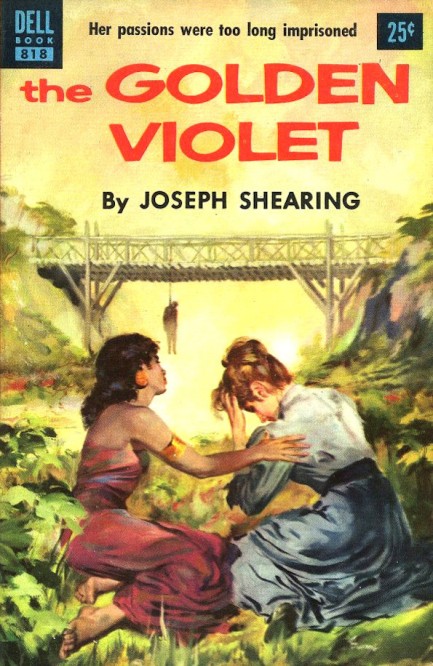
Awhile back we put together a small collection of vintage paperback covers featuring hanging figures. The above cover for Joseph Shearing's The Golden Violet is an addition to that group. Shearing was actually Margaret Gabrielle Vere Long, who earned acclaim writing numerous historical and gothic horror novels, with The Golden Violet part of the latter group. The cover on this Dell edition was painted by Barye Phillips. Side note: the Red Sox are going to miss the playoffs again, and they might even finish last. We're devastated—not. That's for you, Dan. With love, of course.
 I used to show up with a cloak and scythe, but I learned it's simpler to wear a suit and work at the corporate level. 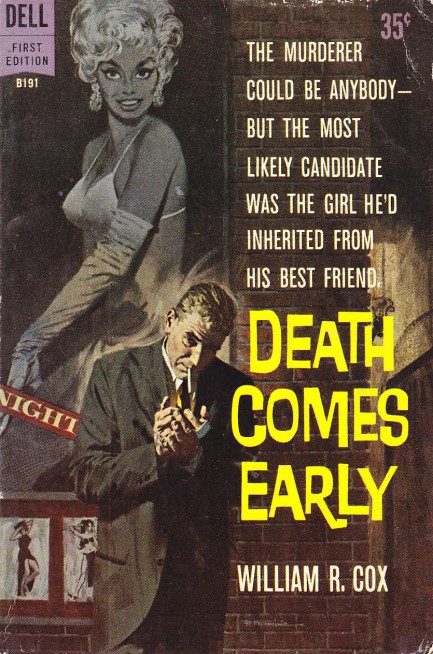
We should start calling Robert McGinnis Robert McAgainis, because he keeps showing up. According to archivist Art Scott, McGinnis painted covers for 1,068 titles in more than 1,400 editions. He is, quite simply, the king of paperback illustrators. He painted the above effort featuring a tough guy loomed over by a femme fatale on a poster for William R. Cox's 1961 thriller Death Comes Early, the tale of a tough nightclub owner who tries to solve the murder of his best friend. The book has a marvelous tone to it, with a more colorful, grittier feel than most crime novels. The women have mileage, the men are impure, and there are few clear motivations in the book's realm of organized crime and dodgy police. While all the characters are interesting, protagonist Jack Ware and his love/hate interest Lila Sharp stand out. Cox's plot unfolds sensibly, as the murder first seems to be about a gambling debt, then something more sinister. We're already on the prowl for more from him.

 I take it from the way you're sprawled across the front seat that dinner and a movie is no longer the plan. 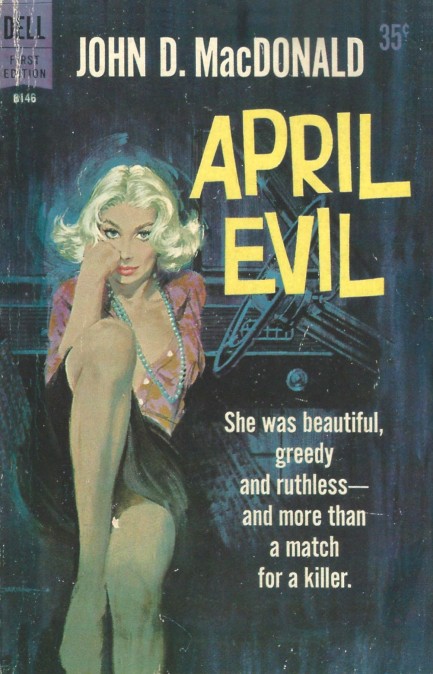
April Evil is a book that showcases John D. MacDonald on literary cruise control, as he confidently weaves together the tale of an elderly, widowed ex-doctor whose has a safe in his study filled with cash, the greedy relatives that hope he leaves his loot and property to them, and how, because rumors of the money have spread, three criminals decide to rob his house. Matters are even more complicated because the doctor has taken in a young married couple, and while the wife is not scheming to get his fortune, the husband is, and he has a big mouth. That mouth entices a psychopathic killer into hijacking the robbery scheme, with the ultimate plan of killing both his partners and—probably—everyone living in the house. For people acquainted with MacDonald but who haven't read April Evil, the approach will be familiar, particularly the character crosscurrents and fateful timing. It's well written, enjoyable, and free of pseudo-sociological content, which we consider to be a problem with McDonald's Travis Magee novels. We recommend it, even more so if you can score Dell's 1956 edition with Robert McGinnis cover art.
 The thrills get lost in the deep end of Rinehart's final novel. 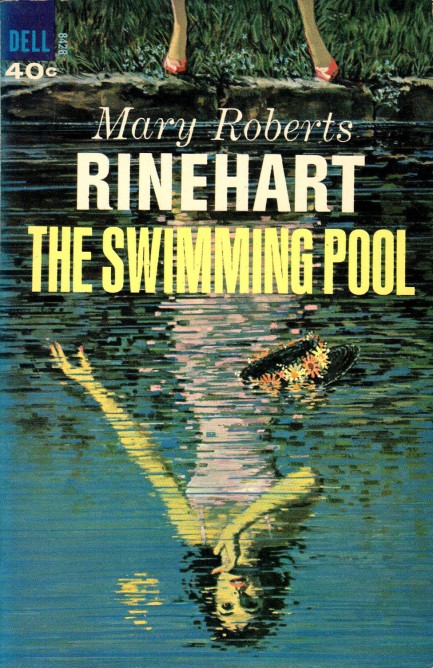
Mary Roberts Rinehart is another of those legendary mystery writers from the pulp era, having launched her career all the way back in 1908. The phrase, “The butler did it,” derives from her work. Of her many novels, we chose to read her 1952 effort The Swimming Pool and our reason was simple—we loved the cover. It was painted by Victor Kalin in a different style than we'd ever seen from him. So with excellent art fronting the work of a major author, we sat down, rubbed our hands together, and thought: “Okay, here we go.” And long story short, The Swimming Pool was definitely too slow to enjoy. And we have a suspicion Rinehart knew it, as her use of foreshadowing to sustain interest is incessant:
Perhaps that excuses her for what happened years later.
I daresay any train east from that Nevada city carries its own load of drama, but I had no idea it was carrying ours.
She was terrified, although it was only after long months of what I can only call travail that we learned the reason for it.
But those inquiries of hers eventually led to her tragic undoing.
And so forth. It occurs particularly at the end of chapters, but it pops up numerous times in other places. It was combined, as well, with the technique of having characters withhold information. We don't mean clandestinely. We mean openly, as in: “I'm not going to tell you that right now. Later perhaps, but not now.” We could have weathered this if it had been only a single character who knew more than he/she said, but there are two important ones here who simply won't speak up. It's a style. We get it. But in real life we'd be like: “Oh you better believe you're going to tell me what you know or this day is going to turn all kinds of bad for you.”
The story deals with two sisters living in a luxurious but neglected estate. The younger sister is a novelist of middling success, while the older one is basically a socialite. For months this older sister has been living in terror, but refuses to tell anyone what the danger is or accept help for her problem. Soon mysterious events occur, such as strange people creeping around the estate, someone taking potshots with a pistol, and a woman drowning in the titular swimming pool. Protection seems to miraculously arrive in the form of a studly renter for the estate's guest cottage, but he has his own agenda, which he reveals at the pace of Chinese water torture.
In fact, Rinehart's entire narrative feels padded, or deliberately drawn out in service of a word count. But here's the thing—she can certainly write. Who are we to even say that? Of course she can write. She published hundreds of stories, scores of novels, and saw her work adapted to cinema or television something like fifty times. But what can we do? We like what we like. The pacing of The Swimming Pool eventually wore us down. We learned only after reading it that it was her last novel, published when she was seventy-six. So we're thinking her spark might be brighter earlier. That means we'll try her again sometime. A serious reader of crime novels could do no less. 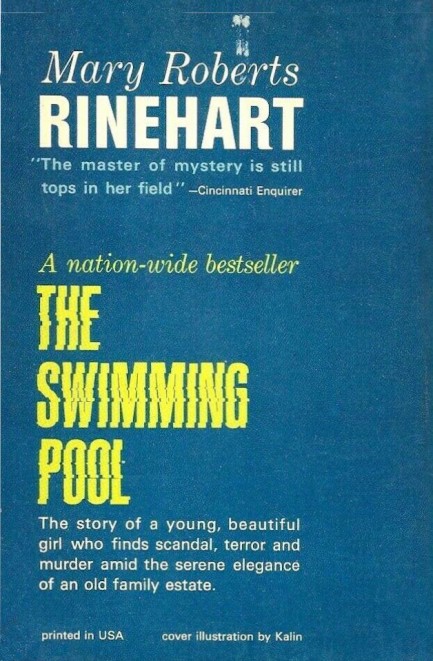
 She could tell them the secret but it would be a bad Korea move. 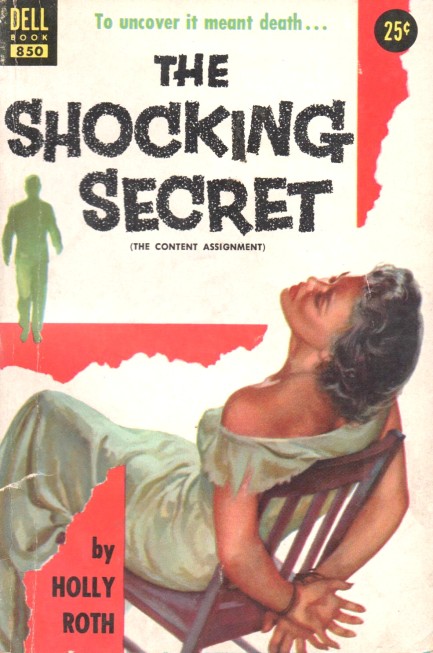
Holly Roth, who also wrote as P.J. Merrill and K.G. Ballard, originally published The Shocking Secret as The Content Assignment in 1954. This Dell edition came in 1955 with William Rose cover art. The story, set beginning in 1948, deals with John Terrant, a British reporter in Berlin whose American love Ellen Content is a CIA agent who disappears during a mission. Nearly two years later her name turns up in a newspaper story that says she's a dancer in New York City. So Terrant crosses the pond to track her down but ends up in the middle of the Cold War, with bad commies and the whole nine.
Roth infuses her tale with an Englishman in New York fish-out-of-water quality, which is occasionally amusing and adds interest, but in the end the entire enterprise comes across lightweight—which is to say it lacks menace and the proper amount of intellectual heft needed for a book about the political/ideological clash of the era. And another issue, though an admittedly nit-picky one, is that the surprise of the title, which we mostly gave away in our subhead, isn't all that shocking. Dell never should have renamed the book.
Moving on to Roth herself, she's one of those writers whose life had an eerie parallel with her fiction. Her 1962 novel Too Many Doctors is about a woman who falls off a ship and loses her memory. In 1964 Roth disappeared from her husband's yacht one stormy night off the coast of Morocco and was never seen again. Officially, her death was an accident. If we get ambitious maybe we'll read Too Many Doctors. While we can't recommend The Shocking Secret, we wouldn't be surprised if several of her other books are better. Her reputation would seem to suggest it.
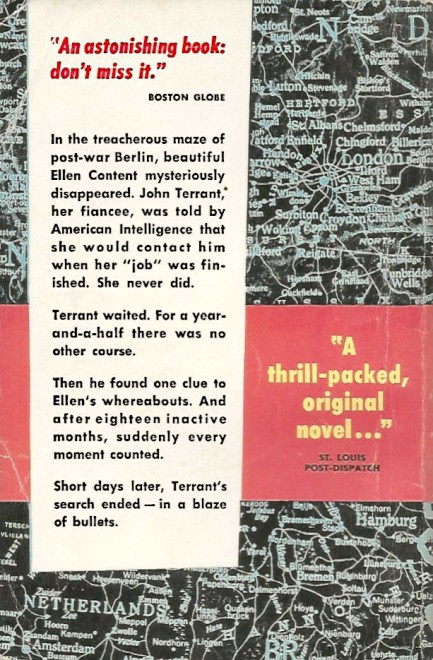

|
 |

The headlines that mattered yesteryear.
2003—Hope Dies
Film legend Bob Hope dies of pneumonia two months after celebrating his 100th birthday. 1945—Churchill Given the Sack
In spite of admiring Winston Churchill as a great wartime leader, Britons elect
Clement Attlee the nation's new prime minister in a sweeping victory for the Labour Party over the Conservatives. 1952—Evita Peron Dies
Eva Duarte de Peron, aka Evita, wife of the president of the Argentine Republic, dies from cancer at age 33. Evita had brought the working classes into a position of political power never witnessed before, but was hated by the nation's powerful military class. She is lain to rest in Milan, Italy in a secret grave under a nun's name, but is eventually returned to Argentina for reburial beside her husband in 1974. 1943—Mussolini Calls It Quits
Italian dictator Benito Mussolini steps down as head of the armed forces and the government. It soon becomes clear that Il Duce did not relinquish power voluntarily, but was forced to resign after former Fascist colleagues turned against him. He is later installed by Germany as leader of the Italian Social Republic in the north of the country, but is killed by partisans in 1945.
|

|
|

It's easy. We have an uploader that makes it a snap. Use it to submit your art, text, header, and subhead. Your post can be funny, serious, or anything in between, as long as it's vintage pulp. You'll get a byline and experience the fleeting pride of free authorship. We'll edit your post for typos, but the rest is up to you. Click here to give us your best shot.

|
|


 Above you see a cover effort by Gerald Gregg for Helen McCloy's 1945 mystery The Man in the Moonlight. This is from Dell Publications, and you probably recognized it right away as a mapback edition. You see that here too, with its fictive university campus.
Above you see a cover effort by Gerald Gregg for Helen McCloy's 1945 mystery The Man in the Moonlight. This is from Dell Publications, and you probably recognized it right away as a mapback edition. You see that here too, with its fictive university campus.



